The beginning of the summer vegetable season is impossible to imagine without cucumbers. Juicy, fragrant vegetable is loved by many. Therefore, in our article: cucumbers - cultivation and care in the open ground, the most pressing issues will be considered not only for beginners, but also for more experienced gardeners.
Material Content:
Cucumbers - varieties for open ground
The first step in the cultivation of any vegetable is the choice of variety and cucumbers are no exception to the rule. When choosing varieties, it is always necessary to take into account the climate of the region in which the cultivation of the vegetable is planned.

You should also decide on the further use of the harvested crop:
- Will it be fresh?
- bookmark for conservation;
- or the use of cucumbers for those and other needs.
In addition, there is a graduation of varieties in three directions:
- early
- medium;
- late cucumbers.
In addition to the above, this culture is divided into two species - self-pollinated (the formation of the ovary without pollen transfer) and pollinated by insects. Both species can be used for planting in open ground.

Currently, breeders have bred a huge variety of cucumber and its hybrid for growing in open ground.
The most popular of them:
- April F1 - a hybrid, belongs to the early varieties. From seedlings to the first harvest only 45-55 days. Bushes are compact. Fruits are long (22-25 cm) with a weight of 200-250 g. Perfect for salads (taste without bitterness) and preservation. It is steady against differences of temperatures and is not picky in leaving.
- Hermann - refers to a self-pollinated species. Fruits by type of gherkins.The first fruits can be obtained 8 weeks after germination. Flowering and ovary occurs over a long period of time. During the season, up to 30 kg of crop can be harvested from one square meter of a plot with cucumbers. Lianas are not fragile, which makes it easy to tie them to the trellis.
- Fontanel F1 - medium ripening, pollinated by insects, hybrid. Good for preservation. Fruits up to 12 cm long and weighing up to 100 g, without bitterness. This hybrid is resistant to many diseases.
- Prestige - a hybrid characterized by active growth and a long fruiting period. Not fastidious in care, has a strong immunity to many diseases.
The number of varieties of cucumbers and its hybrids reaches several thousand names, so many summer residents are lost when choosing seeds.
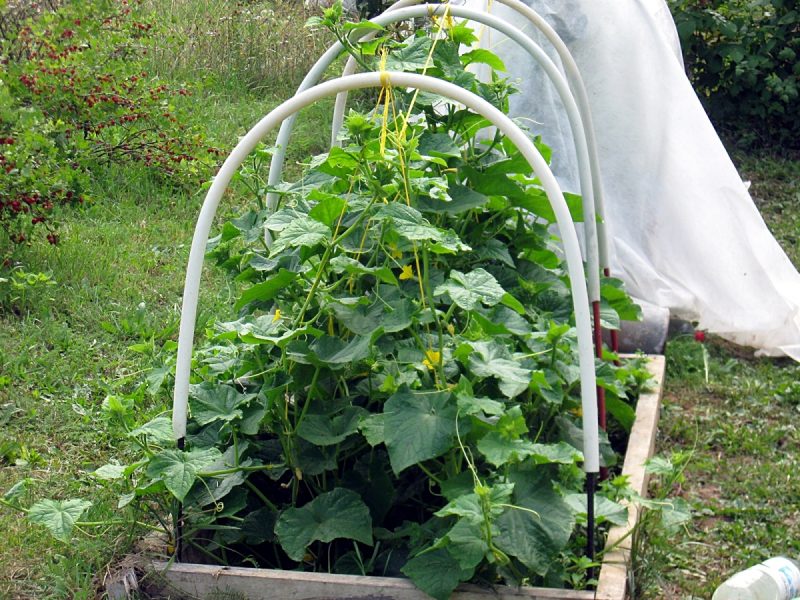
To minimize the risk of making the wrong choice, decide on the main parameters:
- purpose of cultivation;
- Variety preference: early, mid-season or late.
Preparation of seeds and planting material
The key to a good harvest is quality seeds. No matter how the producer praises its seeds, but in order for a strong and healthy plant to grow out of it, it will be necessary to carry out their pre-sowing preparation.
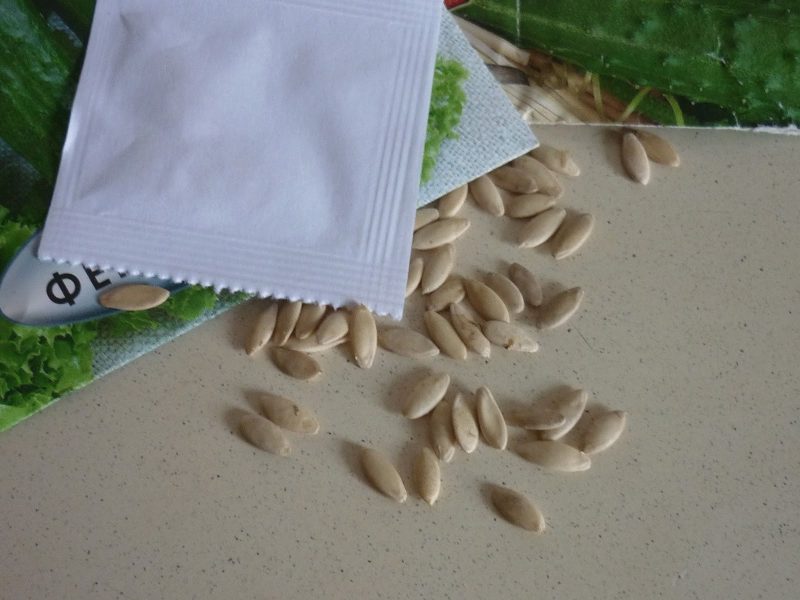
It includes the following steps:
- Calibration and culling - Large, without visible flaws, seeds are selected. Then, using a light aqueous solution of sodium chloride, hollow seeds are thrown out. All seeds are poured with a solution for 5 minutes. And those that have surfaced are removed from the planting material, because nothing will come of them. After this selection, the remaining seeds are washed and dried.
- Warming up - A procedure to accelerate seedlings and stimulate the appearance of female flowers, which will provide an early ovary. Seeds can be warmed by keeping them near heating appliances for a month. If this time is not in stock, then the seeds are calcined at a temperature of 55 degrees for 2-3 hours.
- Disinfection or disinfection carried out to eliminate parasites that may be on the surface of the seeds. It also contributes to plant resistance to potential diseases. Disinfection is carried out with a solution of potassium permanganate. Seeds are immersed and kept in it for 30 minutes. After the procedure, be sure to rinse and dry.
- Nutrient saturation to enhance further growth. For this, the seeds are soaked in an ash solution for up to 2 hours. Then dried.
- Hardening - Prepares the plant for weather changes. Quenching is carried out in the refrigerator throughout the day.
Having passed the difficult path of preparation, the seeds are ready for planting in the ground.
Planting cucumbers in the open ground
Cucumber is a heat-demanding plant. Planting a vegetable is not difficult, but you need to know some of the subtleties of this process in order to achieve the desired result. Post better after tomato, onion, cabbage, potatoes.
Soil and place requirement
Planting cucumbers should begin with a choice of place. A site with good lighting is needed (but so that the cucumber bushes are not located under the scorching sun), and protected from the north, which meets the needs of this plant.
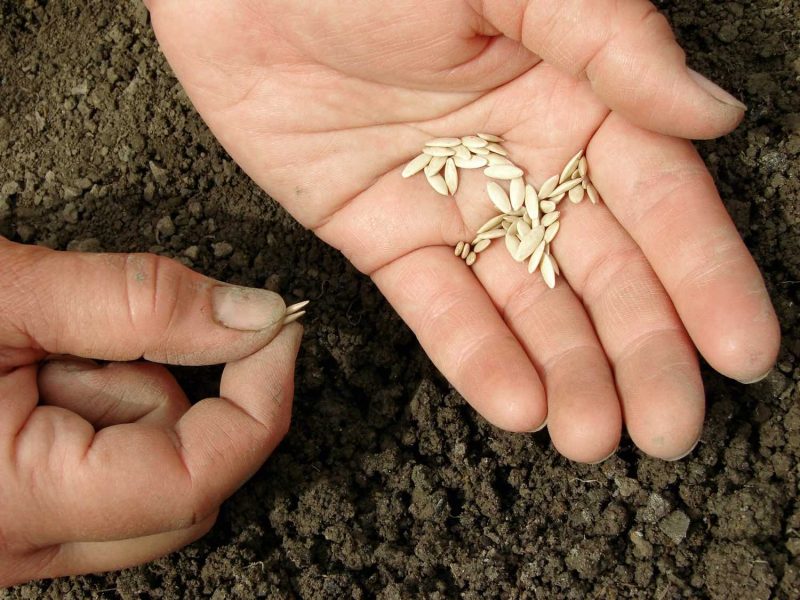
Cucumber grows in any soil, but is best established on loamy, low acid and sandy soils. These types of soil provide good air circulation and moisture absorption.
The presence of groundwater close to the surface can lead to rotting of the root system due to increased humidity.
For better growth, the soil is always fertilized before planting.
How and when to plant?
It is best to plant cucumbers in warm soil with a temperature of at least 15-17 degrees Celsius. The landing period depends on the climatic and weather conditions of the region. It ranges from May 25 - June 5. Too late to plant and grow cucumbers in the summer is also not worth it, because daylight increases and temperature rises, which adversely affects the growth and development of the plant.
Cucumber seeds can be planted in beds next to each other or in separate holes, preferably 2-3 seeds each. The distance between the rows should be at least 50 cm, and sow the seeds at 20 cm distance from each other.
Before planting, rows or holes are abundantly watered, after the seeds are covered with a small layer of earth and watered again. To maintain the necessary temperature and humidity for quick shoots, the rows are covered with a film. When the first sprouts appear, the film is periodically opened, giving air access. As soon as flowers appear, shelter is completely removed from the rows.
Outdoor cucumber care
Cucumbers, like any plant in the garden, need special care. Indeed, without proper attention, it will not please a good harvest or may even die.
Watering schedule
In the care of cucumbers, the most important thing is watering. As a result of insufficient watering, seedlings become weak, poorly developed, bear little fruit, and a taste of bitterness appears in cucumbers. With excess moisture - the root system can simply rot. Water should be in moderation.
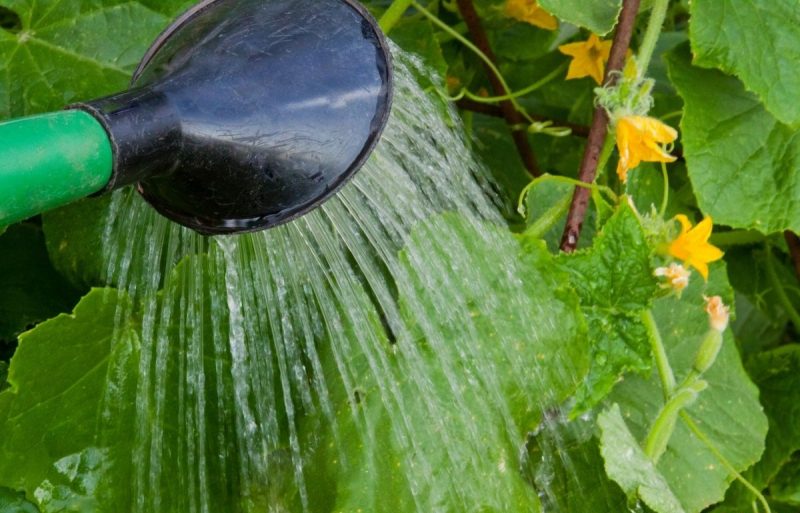
Cucumbers are watered throughout the summer. It is recommended to use water that is well-kept and warm. Cold water from the hose is a stress for the plant, which leads to a slowdown in growth.
At the initial stage of growth, the plant is watered after a little drying of the earth in order to form a strong root system. In the future, the formation of dry crust on the ground is unacceptable. Before the flowers appear, they are watered once every 6 days, and then after 3 to 4 days. You can more often. It all depends on temperature indicators.
Young cucumbers have enough water in the volume of 1 bucket per 1 sq.m. When the plant stops growing, it should be watered at the rate of 1 bucket - 1 bush. Naturally, be careful and try not to wet the trunk and leaves.
Tying and forming a cucumber bush
Two weeks after germination, you can begin to garter and the formation of a bush.

The stem is tied with twine to the trellis with a tight loop, while forming the main stem in parallel. To do this, pluck flowers and shoots in the sinuses, keeping the lateral processes in the amount of 5 to 6 pieces. They are pinched so that the length does not exceed 20 cm. With further growth, the shoots are pinched at a height of 30 cm, and the top ones are allowed to grow to 50 cm and neatly fixed on the trellis. The main stem is pinched 70 cm and thrown over the trellis.
Fertilizing and fertilizers
The first top dressing is carried out after the formation of 2-3 leaves. As fertilizer, you can use mullein (1 liter of solution per 10 liters of water), chicken droppings in combination with ash (2 cups per 10 liters of water). Mineral dressing is carried out with a solution consisting of 15 g of urea and potassium sulfate, 50 g of superphosphate all in 10 l of water.
When fruits begin to appear, the amount of potassium and nitrogen-containing substances in top dressing is increased significantly. For the period of growing cucumbers, fertilizers are applied up to 4 times.
Cucumber Processing

In addition to radical top dressing, cucumbers need surface treatment of bushes, which is carried out as a preventive measure against fungal diseases. To do this, use an effective folk remedy - a solution of iodine with milk (10 liters of water, 1 liter of milk and 30 drops of iodine). This solution can be used to spray cucumbers from seedlings to harvest with a frequency of 7 to 10 days. Processing with this product does not harm the plant and is absolutely harmless to humans.
The main problems associated with growing
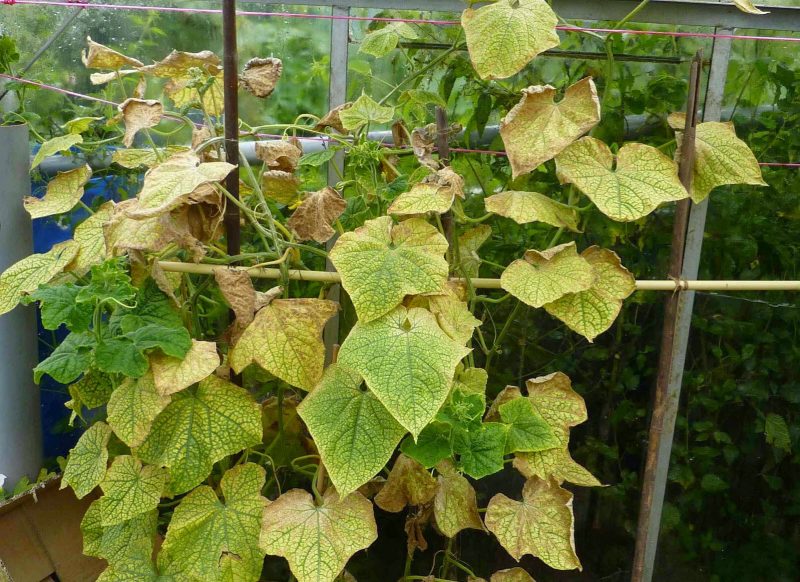
Growing cucumbers in the summer can cause a number of problems:
- Deformation of the fruit is the result of unbalanced top dressing, sudden changes in temperature or untimely watering.
- The presence of bitterness in the taste is a sultry summer, a lack of moisture.
- Yellowed leaves - a lack of nitrogen.
- Bad ovary - there is no pollination (rainy damp weather), high temperature, an excess of nitrogen.
- Extinction of the plant - rotting of the root, or its damage by rodents.
Diseases, pests and methods of dealing with them
Throughout the entire period of development, cucumbers can become a victim of various diseases and pests.
- Powdery Mildew White plaque and reddish spots on leaves and stems are the first signs of this disease. Affected areas are immediately removed. The plant is treated with solutions of colloidal sulfur, mullein or wood ash.
- Gray rot. Fruits and leaves are covered with a touch of gray and brown spots appear. The appearance of the ovary ceases. With such a disease, the intensity of irrigation is reduced, defective places are removed and the ash solution is treated.
- Downy mildew. Oily gray-green spots appear, gradually spreading to the entire sheet and leading to its drying out. Fertilizing and watering should be excluded for a period of 1 week and treat the affected bush with a polycarbacin solution.
- White rot. The plant is covered with white coating up to the root and the process of decay begins. It remains only to remove the affected bush.
- Olive spotting. Fruits of cucumbers are covered with wet spots of brown color. In this case, the plant is sprayed with a light solution of Bordeaux mixture and watering is stopped for 5 days.
- Melon aphid, spider mite and tobacco trip always not averse to settle on bushes of cucumbers. These small insects do great damage to the plant. The leaves dry and fall, the appearance of the ovary ceases, the plant is depleted and fades. I use specialized insecticides to control insects. For prevention, you should always get rid of weeds on which they can propagate.
Collection and storage of cucumbers
Cucumbers are harvested in an unripe form with a frequency of 2 to 3 days, as soon as they reach the required size (8 - 12 cm). It is necessary to remove the fruits from the stems carefully so that the stalk remains on the stalk, and it does not twist.
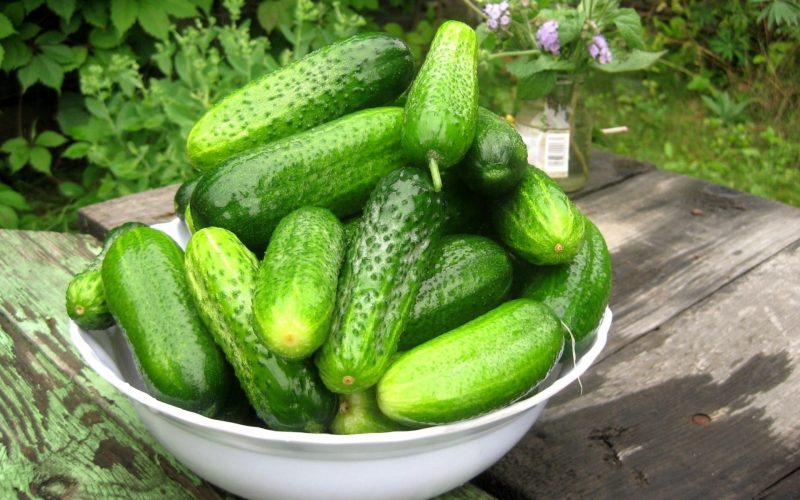
Fresh cucumbers are stored very little. They can be stored in the refrigerator for up to 7 days. Therefore, for the winter, cucumbers are salted in a barrel or canned.
Care and care for cucumbers are the basic principles for a good harvest. Therefore, if you want to achieve the desired results, study the information provided in our article and do not forget to use the recommendations in practice!












